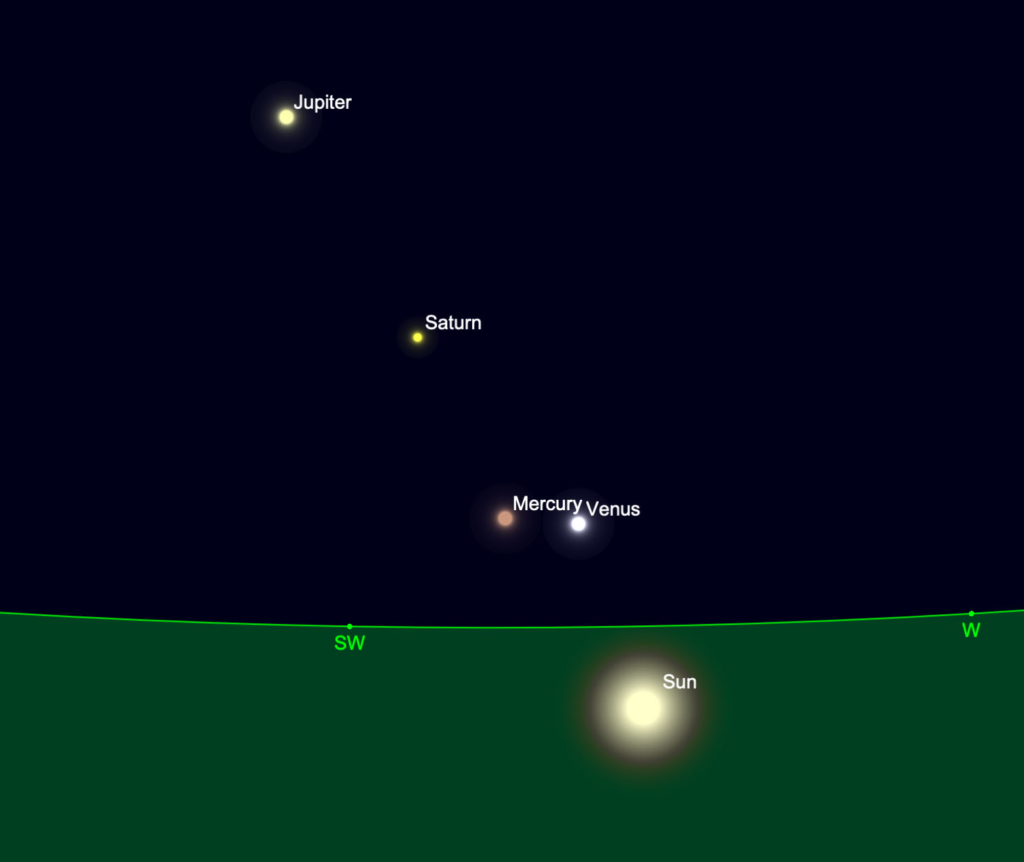Sky Report: December 27, 2021 – January 2, 2022

Four planets 30 minutes after sunset on December 30th. The horizon is translucent so you can see the sun.
Graphic created with SkySafariAstronomy.com.
I’ve been writing about the disappearance of Venus for weeks, and now it happens.
Venus is moving between the earth and sun, and it’s most nearly in line with the sun on January 8th. That’s the day when it officially moves into the morning sky and becomes the “Morning Star” although you won’t actually see it until later in the month.
On the 27th Venus sets 1h 38m after the sun but by the 2nd it sets 1h after the sun and you’ll need a very flat horizon to even try to spot it. On which day will you last see it?
While Venus is losing elevation nightly Mercury is gaining elevation and will make a feeble attempt to replace it, briefly. This is an excellent opportunity to see Mercury – a planet that surprisingly few people have ever seen.
Mercury was 7° straight below Venus on the evening of the 25th, but you wouldn’t have seen it so near the horizon. On the 28th they’re at their closest, only 4-1/4° apart with Mercury at the 8:00 position from Venus, and you can see them together in binoculars, which you’ll need.
A better night might be the 30th when Mercury is a bit higher and straight to the left of Venus; then they’ll be separated by 5½°, still close enough to see them together in binoculars (which every stargazer must have).
Mercury is quite bright but Venus is 33 times brighter, so they’re an uneven pair. Mercury is smaller (diameter 3032 vs. 7521 miles), darker (6% vs 75% reflective), and more distant (112 vs. 26 million miles), and hence the great disparity in their brightness.
Don’t pass up this brief opportunity to spot Mercury.
Mercury remains visible in evening twilight until the middle of the month when it does then what Venus is doing now – moves between the earth and sun. At the end of the month it attempts, unsuccessfully, to join Venus in the morning sky.
Jupiter and Saturn remain easily visible low in the southwest after sunset, but they too are lower each night. Enjoy them now; we’ll lose Saturn in only weeks and Jupiter in February – leaving the evening sky devoid of bright planets. Jupiter is by far the brighter of the two, and Saturn is below it at the 5:00 position.
Mars is in the morning sky, and on the morning of the 31st the moon is close to both Mars and the orange star Antares in Scorpius. The three form a compact equilateral triangle about 5° on a side, so all will fit in the view of most binoculars. The ultra-thin crescent moon points the way; Mars is to the moon’s lower left while Antares is the same distance to the moon’s lower right, and the two are a similar magnitude. This is a great opportunity to spot Mars as it comes into view after passing behind the sun last October. Mars will be closest – and brightest – this coming December.
Thanks to a grant from the Utah Governor’s Office of Economic Development and the Kane County Office of Tourism, Stellar Vista Observatory offers portable telescopes and tripod mounted binocular kits on loan for free to all residents of Kane County. Nothing beats a quality binocular or astronomical telescope to enhance enjoyment of the night sky! Visit https://stellarvistaobservatory.org/discover-the-night-sky/ or Kanab City Library for full details.
The Sky Report is presented as a public service by the Stellar Vista Observatory, a nonprofit organization based in Kanab, Utah, which provides opportunities for people to observe, appreciate, and comprehend our starry night sky. Additional information is at www.stellarvistaobservatory.org. Send questions and comments to John@StargazingAdventures.org.






Comments are closed.